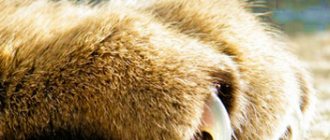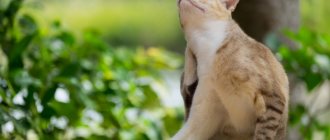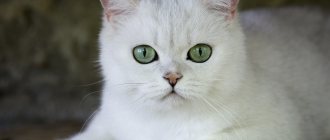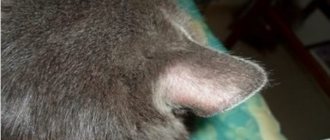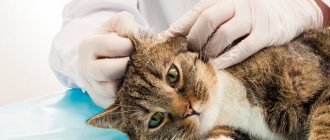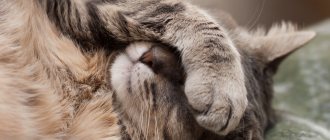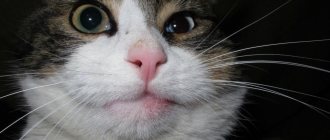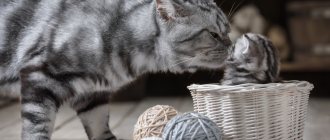Why is it important to regularly look after your cat's claws?
Your cat's claws need to be looked after regularly because:
- Claws are the most important part of a cat's paw. These animals are predators, their claws are a strictly functional part of the body, on which the biomechanics of the limb is largely “tied”. If there is something wrong with them, the pet will not be able to walk, play or run normally.
- The claw is an integral part of a cat's toes. If it is somehow damaged, or if some kind of infection “eats” it, the fingers themselves will inevitably suffer. And in advanced cases, this may well lead to the need for amputation.
- Some claw diseases (fungus, for example) are also dangerous for humans. Therefore, it is in the owner’s interests to quickly identify them and begin treatment, so as not to endanger their health and the health of other people who come into contact with a sick cat.
How to detect the problem?
It is very easy to notice that a cat’s claw has grown into the pad; just watch the animal’s behavior. Such a nuisance will torment the cat, so it will try to gnaw out the ingrown claw, which can lead to damage to the pads.
Over time, this will manifest itself as lameness on the hind or front legs. The animal's gait will change, the cat will begin to distribute its body weight differently so as not to disturb the sore paw. Your pet will avoid active games and try to jump less so as not to accidentally damage the ingrown claw.
When examining the paw pad, it will become noticeable that the claw is deformed and growing incorrectly. In this case, the pad itself may swell and peel off. The claw becomes curved, and its tip is hidden under the pad, while any touch of the owner to this area causes pain, so the pet will try to escape.
You might be interested in: Why do my cat's ears turn red inside?
Ingrown claw
Ingrown claw is one of the most common pathologies. In this case, the claw is strongly bent or twisted, after which, growing in the wrong direction, it digs into either the pad of the paws or the interdigital space.
Cats' claws (like human nails) grow constantly throughout life. Under normal conditions, they wear off when the animal walks or runs. In addition, everyone is well aware of the habit of cats who love to sharpen their claws. This process is extremely important, as it promotes natural grinding of the nail plates.
The reason for the ingrowth of the claw lies precisely in the disruption of the process of its natural grinding. This happens in the following cases:
- The cat is too old and physically cannot move actively and much.
- The animal suffers from obesity and concomitant inactivity.
- With all this, owners forget to trim their pets’ claws on time, or they simply do not know about such a need.
Unbalanced feeding
The owner gives the cat a treat
. The separation indicates the carelessness of the owner. To ensure normal regrowth of claws, building material is needed, primarily vitamins. Most cat owners have no idea about the diet and feed them whatever they need: table scraps, raw fish or meat, milk, treats that the pet begs from the compassionate owner.
For owners, especially children, the sight of a pet eating something delicious evokes emotion, but such food does nothing but harm the cat’s health.
Be sure to read:
What causes growths on the pads of cats front or back paws?
It’s even worse when the owner combines natural products with ready-made food. Nutrients enter into an antagonistic interaction and an imbalance of vitamins and other biologically active compounds develops. Owners thoughtlessly use vitamin supplements, which are sold in abundance in pet stores. However, in this case there is an excess of biologically active substances, which is more harmful than a deficiency.
The optimal solution to the problem is to use ready-made food of at least premium class. It contains all the necessary amino acids, vitamins, fatty acids, minerals that ensure the health of the pet, including its claws. Adherents of natural food will have to work hard: to create a diet from natural products that is not inferior in concentration of nutrients to ready-made premium food. In this case, you cannot do without vitamin and mineral supplements. And your veterinarian will help you choose.
Panaritium (inflammation of the claw bed)
If we compare them with dogs, felons (inflammation of the claw bed) are much less common in cats. Normally, near the base of the claw there is a layer of dense, tough skin that protects the organ from negative environmental factors. Due to injuries, this layer is damaged, as a result of which bacterial and fungal microflora gain access to the soft tissues.
Most often, this disease occurs in cats living in rural areas and constantly walking outside.
Symptoms
The pathology has quite characteristic symptoms:
- Since inflammation is accompanied by severe pain, the cat prefers not to lean on the affected paw. If he has to do this, the pet hisses and meows strongly, “with anguish.”
- For the same reasons, the animal constantly licks and even gnaws its own paws.
- When examining the paws, it is clearly noticeable that the skin around the base of the claws is red, swollen, hot, and in many cases exudate oozes from there.
Treatment
As in the previous case, the treatment is not particularly difficult:
- The affected paw is kept in a saturated solution of Epsom salts (Epsom salt) three times a day for 10-15 minutes, or in a saturated solution of ordinary sodium chloride (table salt). This helps to pull exudate from the tissues and stop the inflammatory process.
- In severe cases (especially with the interference of putrefactive microflora), complete excision of the claw, and in some cases of the entire finger, is recommended.
- In most cases, broad-spectrum antibiotics are prescribed.
Causes of nails growing into pads
There are several factors that cause an animal's nail to begin to
round and penetrate into the soft tissues of the paw. First of all, this is insufficient and illiterate care of the owner. Trimming too infrequently or shortening it to a short length leads to rapid regrowth of the cat’s nail.
Experienced owners and veterinarians note that ingrowth occurs more often in older pets than in young ones . In an aging body, there is a deficiency of minerals and vitamins, which leads to impaired nail growth and deformation.
The growth defect and change in the shape of the formidable cat weapon are also influenced by genetic predisposition. Breeders note that if a cat was prone to this disease, then the offspring often have problems with the nail growing into the paw.
Various injuries and mechanical damage to the limb can lead to trouble, causing a change in the shape of the nail and an increase in its length.
We recommend reading about why a cat is limping on its paw. You will learn about the causes of limping in cats, how the owner can help their pet, and treatment options. And here is more information about how to help a cat with a broken tail.
Pododermatitis
Pododermatitis or inflammation of the soft tissues of the paws is the most common disease in cats and dogs. During pododermatitis, the animal has difficulty taking normal steps, and any movement leads to severe discomfort and pain. Because of this, cats and kittens develop nervousness and aggressive behavior.
© shutterstock
It is difficult to identify this diagnosis in the first stages; they are impossible for the average person to notice. Therefore, the disease starts, and the consequences become irreversible.
Causes of the disease:
- influence of pathogenic bacteria. When a cat has injured its paw, the variation in bacteria entering the body increases significantly. Incorrect disinfecting manipulations cause fungal manifestations in the tissues of the paws. It is difficult to detect and even more difficult to treat. Most often, the result is a chronic fungal disease.
- hypothermia. During the cold period, there is a risk of severe hypothermia, and therefore it is not recommended to let cats go for a walk during this period. The streets are filled with chemicals, and they can irritate the delicate tissue of the paws, which can cause necrosis in felines. Because of this, the pads are completely destroyed, and as a result - lameness.
- exposure to allergens. Allergens can cause dermatitis; indoor cats are more susceptible to this. A weakened animal's immune system may not cope well with this disease.
- consequences of autoimmune diseases. Most often, plasmacytic pododermatitis appears after autoimmune diseases. Due to the late detection and treatment of the disease, it is necessary to give the cat special medications throughout its life to keep the disease under control.
Symptoms and diagnosis of pododermatitis
Every second observation will help to identify any disease in the early stages, and contacting a specialist in the early stages will help to avoid negative consequences and quickly cure feline diseases in a cat.
In the initial stages of paw pad problems, there are various symptoms:
- the cat spends a lot of time on paw hygiene
- the pads are very soft
- From time to time blood is visible on the surface of the pads
Ignoring any of the signs can contribute to the development of severe necrosis, which carries with it a high likelihood of sepsis. In this case, veterinarians cannot guarantee a high survival rate for the cat, and most methods of treating the disease are ineffective.
© shutterstock
Prevention of ingrown nails
Veterinary specialists and experienced breeders believe that to prevent claws from growing into soft tissues, owners of furry pets should adhere to the following rules and recommendations:
- Trim your animal's nails regularly using sharp nail clippers. After trimming, be sure to file the edge.
- If your pet is prone to ingrown hairs, you should have your pet professionally trimmed for several months in a row. This manipulation will straighten the shape of the nail and prevent the further development of the defect.
- Carry out regular inspection of the animal's paws to identify nail defects.
- Protect your pet from limb injuries.
Ingrown toenails in domestic cats are quite common. The owner’s task is to timely detect the violation and provide assistance to the pet. In advanced cases, only surgery can help a furry patient. To prevent the disease, the owner should regularly and competently carry out a cat manicure.
Cats and claws
Cats grow fur all year round and twice a year, as the seasons change, they go through a major shedding process to ensure they have the appropriate coat for the upcoming warmer or cooler weather. Cats also change their whiskers and eyebrows, and sometimes the sheaths of their claws.
Since its sheath is very similar to a full cat's claw, for a new cat owner to find a cat's claw sheath for the first time at home may seem like a strange and alarming sign, but changing claw sheaths is a normal process for any domestic cat and is not a sign of illness.
What is a claw sheath?
Your cat's claws are made of tough, keratin protein that is very strong and durable. The claws are so strong in order to support the weight of the cat while climbing trees, curtains and other vertical objects in their environment. However, unlike dog nails, which continue to grow unless they are trimmed or worn down by walking on hard, rough surfaces, cat nails grow to a certain point of self-limitation, after which they stop growing in length.
While dogs may have problems with overgrowth of nails curling inward and growing into the pads of their toes, cats' nails will not continue to grow and grow unless the growth is artificially stopped.
The sheath is the outer layer of the claw itself, and claws have a layered structure and grow in layers, starting with the newest growth in the center and the oldest layers of growth on the outside.
Why do cats shed the sheaths of their claws?
To remain functional, a cat's claws must be strong, sharp and
practical, meaning that when the sheath of the claw begins to stretch a little at the tip, your cat will shed it off the claw to reveal a new, strong and sharp claw. A domestic cat's skin renews itself on a cyclical basis every three months - meaning that every three months or so, your cat will replace all of its previous claws with new ones.
Scratches and healthy claws
Cats need to scratch things to keep their claws sharp and short enough to be practical, and this process helps remove old layers of claws. To help your cat change its claws, install a scratching post or sisal post in your home!
Scratching things also allows your cat to exercise the muscles in her hands and feet by extending and retracting her claws, keeping them in good condition and allowing your cat to grasp, lift, catch and hold prey.
Provide your cat with a scratching post or a place to scratch, otherwise she will almost certainly find an alternative on her own, such as the living room rug, the legs of your sofa, and the like.
If your cat's claws grow too slowly for the animal to shed the claw sheaths on its own, you may need to trim the very tips of the claws, being careful not to damage the blood- and nerve-rich living tissue in the claws, which will bleed profusely if damaged. Also, an acute injury will cause pain and be a nuisance for your cat.
As mentioned, your cat's claws need to be sheathed approximately every three months, but you should still keep the claws hard, strong, and healthy. Although you may occasionally see a partially detached claw on one of your cat's toes, you should not attempt to remove or remove it yourself. Your cat's nails should not be weak, thin or flaky.
If your cat's nails are too soft or very weak, they may be lacking calcium or another important vitamin or mineral or protein. If this occurs, you should speak with our veterinarian about why this may be and possibly use supplements to restore your animal to normal health.
However, you should never give supplements or dietary products to your cat without first consulting with a qualified veterinarian—it may be inappropriate or even harmful to the cat. It is necessary to establish and correct the main cause of the disturbance in the replacement and growth of the animal’s claws.
Defect detection
The owner can easily identify the problem in his pet. Symptoms that indicate an ingrown toenail in a cat include :
- The pet begins to noticeably limp. An ingrown toenail affects soft tissues and creates discomfort and pain while walking. The animal limps, carefully stepping on the paw, which hurts.
- The cat's increased attention to the paw that is bothering him becomes noticeable: he licks the pad, tries to bite off the nail.
- The pet will begin to avoid active games, during which the sore leg may be disturbed, and will begin to jump less.
- The affected finger may experience swelling and redness.
After a visual inspection, you can find a nail of impressive length, the tip of which is stuck into the soft tissue. When pressing on the pad, the animal begins to show anxiety, breaks out, hisses, and bites.
An ingrown toenail can cause inflammation and become a source of infection. In some cases, an abscess may develop, so treatment should not be delayed.
Proper nail trimming - how to do it to avoid problems?
If your cat's nails peel after trimming, you will have to understand the specifics of the procedure in order to avoid troubles in the future. The first thing to remember is that using ordinary scissors is prohibited. For manipulation, it is recommended to purchase special tweezers designed to shorten the stratum corneum. Step-by-step procedure:
- Wash your hands thoroughly.
- Make sure the tweezers are sharp and sharpen them a little if necessary.
- Disinfect the instrument.
- Remove only the tip of the claw, leaving a significant distance to the pink tissue.
Pay special attention to the fifth toe of your pet - the nail on it is much shorter than the others, so it is easy to injure the pad on the animal’s paw, it begins to peel and hurt. Here you need to shorten the nail plate often - since the keratinized tissue is practically not ground off, you will have to use tweezers. Lack of trimming can cause the nail to grow into the pad, resulting in pain and even injury to the cat.
Treat the sections with a disinfectant and, if necessary, re-straighten the ends. Repeat the procedure regularly, but do not overdo it - you only need to cut off the stratum corneum. If it is difficult to cope with the manipulations on your own, it is recommended to go to a veterinary clinic - specialists will show you how to properly carry out a haircut.
Why do they release claws?
A cat puts out its claws - it means it’s getting high :)
It often happens that the cat is marking time or lying on its knees and releasing its claws at this time. Why a cat releases its claws is very important to know. After all, many owners begin to trim their cat’s claws and scold her when she puts out her claws at the wrong moment, but this is not recommended.
In fact, the phenomenon when a cat moves its paws and this is accompanied by the release of its claws is called a “milk step”. This comes from childhood, when kittens, when feeding on mother's milk, press on the mother's mammary glands with similar movements. Usually a milk step is a sign of affection from a cat, so you should never scold it. If these movements cause you discomfort, simply purchase soft silicone claw attachments.
Gimpet Katzen Grass Fast-germinating grass for cats, 100 g
Price: 131 rub.
177 rub.
26% discount for you!
Cleanses the gastrointestinal tract and prevents constipation. Fast delivery throughout Russia. And also more than 3,000 other pet products at competitive prices! Take a look!
Treatment at home
Only a few know or have heard about what to do if a cat has an ingrown claw in its pad. A person’s first instinct is always to straighten the claw and pull it out with his hand. But this is absolutely forbidden.
To help his cat, the owner must have special clippers for trimming animal claws. The instrument should be disinfected with alcohol (cologne or vodka). The place where the claw has grown is also moistened with an antiseptic. An ingrown toenail is cut off before reaching the pink part where the blood vessels pass, so as not to damage them .
After trimming, the nail is removed from the pad by grabbing it by the edge with nippers or tweezers, with a sharp movement in the opposite direction of growth. It is important to do the removal quickly, as the procedure is painful and the cat will not like it. As a rule, the nail comes out easily without damaging nearby tissues.
© shutterstock
The place from which the defective nail was removed must be disinfected with hydrogen peroxide or furatsilin solution. You can also apply antibacterial ointment to the wound to prevent infection. The rest of the nail is shortened to the maximum possible height using a nail clipper.
Self-treatment can be carried out only if there is no inflammation at the site of ingrowth. If, upon examination, swelling and redness are detected at the site where the nail enters the soft tissue, then it is not recommended to treat the cat’s nail at home. Contact a specialist.
Breaking off claws and cracks in pads
One of the common paw problems among representatives of the cat family is broken claws and the formation of cracks on the paw pads; this occurs as a result of injury or mechanical damage to the animal’s paw. When a crack appears on the claws, or they break off for any reason, this may be the beginning of purulent inflammation of the corolla, and then the claw will fall off on its own.
© shutterstock
In particularly advanced cases, the corolla and claws are removed surgically. It is necessary to monitor the condition of the cats’ claws, and if sharp ends are detected, remove them painlessly and apply an antiseptic for the wounds. For cracks and damage, a bath with a disinfecting effect is recommended; it helps relieve inflammation and eliminate the problem. In particularly severe cases, veterinary supervision is necessary.
How to help your cat overcome split claws
There are several ways to help your cat deal with the problem of split claws:
- If a mustachioed dog has lost its claws, then a scratching post will help him cope with this problem perfectly. You can choose a floor-mounted, wall-mounted or corner scratching post, which is made of various materials that your kitten will like. Place it in your pet’s favorite place, and he will easily and independently get rid of the exfoliated shell, because of which he experiences discomfort every time he retracts his claws into his paw.
- In the case when you decide to cut the nails yourself, then for the first time it is better to contact a veterinarian, he will tell you and show you how to do it correctly so as not to harm your pet. After all, if after a haircut the cat’s claws begin to peel off, this is not the worst thing that could happen. It will be much worse if you touch the nerve endings with careless and incorrect circumcision, and the cat will experience unbearable pain. You can also provoke bleeding or inflammation of the cat’s claws, and then you definitely won’t have any problems.
- If your pet regularly uses a scratching post and you trim each nail correctly and efficiently, and the problem with delamination of the claws has not gone away, then you should still pay attention to its nutrition. You need to know that in this case the cat lacks vitamins and her claws peel off.
